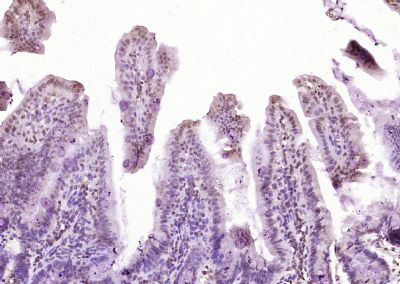产品货号 : mlR11684
英文名称 : NPEPPS
中文名称 : 嘌呤霉素敏感性氨肽酶蛋白抗体
别 名 : PSAP; AAP-S; aminopeptidase puromycin sensitive; Cytosol alanyl aminopeptidase; METALLOPROTEASE 100; METALLOPROTEASE MP100; MP 100; MP100; Npepps; PSA; PSA_HUMAN; Puromycin sensitive aminopeptidase; Puromycin-sensitive aminopeptidase.
研究领域 : 细胞生物 神经生物学 Alzheimer's
抗体来源 : Rabbit
克隆类型 : Polyclonal
交叉反应 : Human, Mouse, Rat, Dog, Pig, Cow, Horse, Sheep,
产品应用 : ELISA=1:500-1000 IHC-P=1:400-800 IHC-F=1:400-800 ICC=1:100-500 IF=1:100-500 (石蜡切片需做抗原修复)
not yet tested in other applications.
optimal dilutions/concentrations should be determined by the end user.
分 子 量 : 103kDa
细胞定位 : 细胞浆
性 状 : Lyophilized or Liquid
浓 度 : 1mg/ml
免 疫 原 : KLH conjugated synthetic peptide derived from human NPEPPS:201-300/919
亚 型 : IgG
纯化方法 : affinity purified by Protein A
储 存 液 : 0.01M TBS(pH7.4) with 1% BSA, 0.03% Proclin300 and 50% Glycerol.
保存条件 : Store at -20 °C for one year. Avoid repeated freeze/thaw cycles. The lyophilized antibody is stable at room temperature for at least one month and for greater than a year when kept at -20°C. When reconstituted in sterile pH 7.4 0.01M PBS or diluent of antibody the antibody is stable for at least two weeks at 2-4 °C.
PubMed : PubMed
产品介绍 : Puromycin-sensitive aminopeptidase is a 100kDa zinc metallopeptidase which degrades neuropeptides by removing amino acid residues from the amino-terminus. The protein is the most abundant aminopeptidase in the brain, however it is not exclusive to that organ. It is localized primarily in the cytoplasm, and plays a role in the metabolism of neuropeptides in nerve terminals and synaptic clefts. The human PSA gene maps to chromosome 17q 2-32.
Function:
Aminopeptidase with broad substrate specificity for several peptides. Involved in proteolytic events essential for cell growth and viability. May act as regulator of neuropeptide activity. Plays a role in the antigen-processing pathway for MHC class I molecules. Involved in the N-terminal trimming of cytotoxic T-cell epitope precursors. Digests the poly-Q peptides found in many cellular proteins. Digests tau from normal brain more efficiently than tau from Alzheimer disease brain.
Subcellular Location:
Cytoplasm.
Tissue Specificity:
Detected in liver, epithelium of renal tubules, epithelium of small and large intestine, gastric epithelial cells, and alveoli of the lung (at protein level).
Similarity:
Belongs to the peptidase M1 family.
SWISS:
P55786
Gene ID:
9520
Important Note:
This product as supplied is intended for research use only, not for use in human, therapeutic or diagnostic applications.
产品图片












